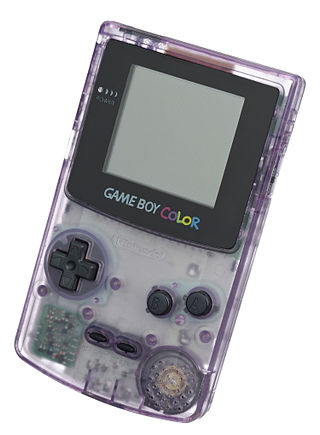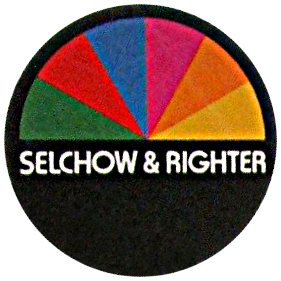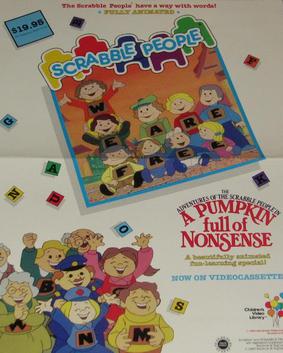
Coleco Industries, Inc. was an American company founded in 1932 by Maurice Greenberg as The Connecticut Leather Company. It was a successful toy company in the 1980s, mass-producing versions of Cabbage Patch Kids dolls and its video game consoles, the Coleco Telstar dedicated consoles and ColecoVision. While the company ceased operations in 1988 as a result of bankruptcy, the Coleco brand was revived in 2005, and remains active to this day.

The Game Boy Color is an 8-bit handheld game console, manufactured by Nintendo, which was released in Japan on October 21, 1998, and to international markets that November. It is the successor to the Game Boy and is part of its product line. Compared to the original, the Game Boy Color features a color TFT screen rather than monochrome, a processor that operates twice as fast, and has four times as much memory. It retains backward compatibility with games initially developed for its predecessor. However, despite these improvements, reviewers consider the Game Boy Color an evolution rather than a revolutionary leap in handheld gaming technology.

Scrabble is a word game in which two to four players score points by placing tiles, each bearing a single letter, onto a game board divided into a 15×15 grid of squares. The tiles must form words that, in crossword fashion, read left to right in rows or downward in columns and are included in a standard dictionary or lexicon.

Trivial Pursuit is a board game in which winning is determined by a player's ability to answer trivia and popular culture questions. Players move their pieces around a board, the squares they land on determining the subject of a question they are asked from a card. Each correct answer allows the player's turn to continue; a correct answer on one of the six "category headquarters" spaces earns a plastic wedge which is slotted into the answerer's playing piece. The object of the game is to collect all six wedges from each "category headquarters" space, and then return to the center "hub" space to answer a question in a category selected by the other players.

Anagrams is a tile-based word game that involves rearranging letter tiles to form words.

Parker Brothers was an American toy and game manufacturer which in 1991 became a brand of Hasbro. More than 1,800 games were published under the Parker Brothers name since 1883. Among its products were Monopoly, Clue, Sorry!, Risk, Trivial Pursuit, Ouija, Aggravation, Bop It, Scrabble, and Probe. The trade name became defunct with former products being marketed under the "Hasbro Gaming" label with the logo shown on Monopoly games.

Parcheesi is a brand-name American adaptation of the Indian cross and circle board game Pachisi, published by Selchow & Righter and Winning Moves Games USA.
Anti-Monopoly is a board game made by San Francisco State University Professor Ralph Anspach in response to Monopoly. The idea of an anti-monopoly board game dates to 1903 when Lizzie Magie created The Landlord's Game, which later inspired Monopoly.

Alfred Mosher Butts was an American architect, famous for inventing the board game Scrabble in 1938.
This page lists board and card games, wargames, miniatures games, and tabletop role-playing games published in 1986. For video games, see 1986 in video gaming.

Cnapan is a Welsh form of Celtic medieval football. The game originated in, and seems to have remained largely confined to, the western counties of Wales, especially Carmarthenshire, Ceredigion and Pembrokeshire. According to George Owen of Henllys, in his Description of Pembrokeshire (1603), cnapan had been "extremely popular in Pembrokeshire since greate antiquitie". Cnapan was one of the traditional ball games played to celebrate Shrovetide and Eastertide in the British Isles. These games were the forerunners of the codified football games first developed by Public Schools which led to the creation of Association football and Rugby football in the 19th century. Cnapan continued to be played until the rising popularity of Rugby Union Football resulted in the game falling into decline.

The McDonald's All American Game is the all-star basketball game played each year for American and Canadian boys' and girls' high school basketball graduates. Consisting of the top players, each team plays a single exhibition game after the conclusion of the high-school basketball season, in an East vs. West format. As part of the annual event, boys and girls compete in a slam dunk contest and a three-point shooting competition, and compete alongside All-American Game alumni in a timed team shootout. The last of these competitions replaced separate overall timed skills competitions for boys and girls. It is rare for girls to compete in the slam dunk contest. They have, however, won it three times—in 2004 by Candace Parker, in 2019 by Fran Belibi, and most recently in 2022 by Ashlyn Watkins. The boys' game has been contested annually since 1978, and the girls game has been played each year since it was added in 2002.

The Adelaide Footy League, formerly known as the South Australian Amateur Football League (SAAFL), is a semi-professional Australian rules football competition based in Adelaide, South Australia. Comprising sixty-seven member clubs playing over one hundred and ten matches per week, the SAAFL is one of Australia's largest Australian rules football associations.

Selchow and Righter was a 19th- and 20th-century game manufacturer best known for the games Parcheesi and Scrabble. It was based in Bay Shore, New York.

The Game Boy is an 8-bit, fourth generation, handheld game console developed by Nintendo, launched in the Japanese home market on April 21, 1989, followed by North America and Europe later that year. Designed by the team behind the Game & Watch handhelds and NES games, it was Nintendo's first portable console, combining features from both.

The board game Monopoly has its origin in the early 20th century. The earliest known version, known as The Landlord's Game, was designed by Elizabeth Magie and first patented in 1904, but existed as early as 1902. Magie, a follower of Henry George, originally intended The Landlord's Game to illustrate the economic consequences of Ricardo's Law of economic rent and the Georgist concepts of economic privilege and land value taxation. A series of board games was developed from 1906 through the 1930s that involved the buying and selling of land and the development of that land. By 1933, a board game already existed much like the modern version of Monopoly that has been sold by Parker Brothers and related companies through the rest of the 20th century, and into the 21st. Several people, mostly in the midwestern United States and near the East Coast of the United States, contributed to its design and evolution.
Scribbage is a classic dice word game published in 1959 by the E.S. Lowe Company. 13 dice are rolled which have various letters on each side. Each letter is given a point value depending on its frequency in the English language. A timer is flipped and the player has to put the dice into words either left-to-right or up-and-down. The words must connect with each other as in crossword puzzles or Scrabble. The player must stop at the end of the time and points are counted. The player adds up the points of the letters used and subtracts the amount from the unused letters. Scribbage can be played with two or more players.

The Adventures of the Scrabble People in A Pumpkin Full of Nonsense is an animated television special from 1985, made at Jaime Diaz Studios in Buenos Aires, Argentina. It was produced and directed by Alvaro Arce, and co-directed by Jaime Diaz. In the special, a character called Sir Scrabble and two children travel to a land called Nonsense, where education has been forbidden. Sir Scrabble teams up with the residents to defeat an evil ruler, the Muddler, through the power of learning and spelling.
Harriet T. Righter was an American businesswoman, the president of Selchow and Righter, a game company, which was co-founded by her father. Her best-known addition to the company's properties was Scrabble, which she thought was "a nice little game".














